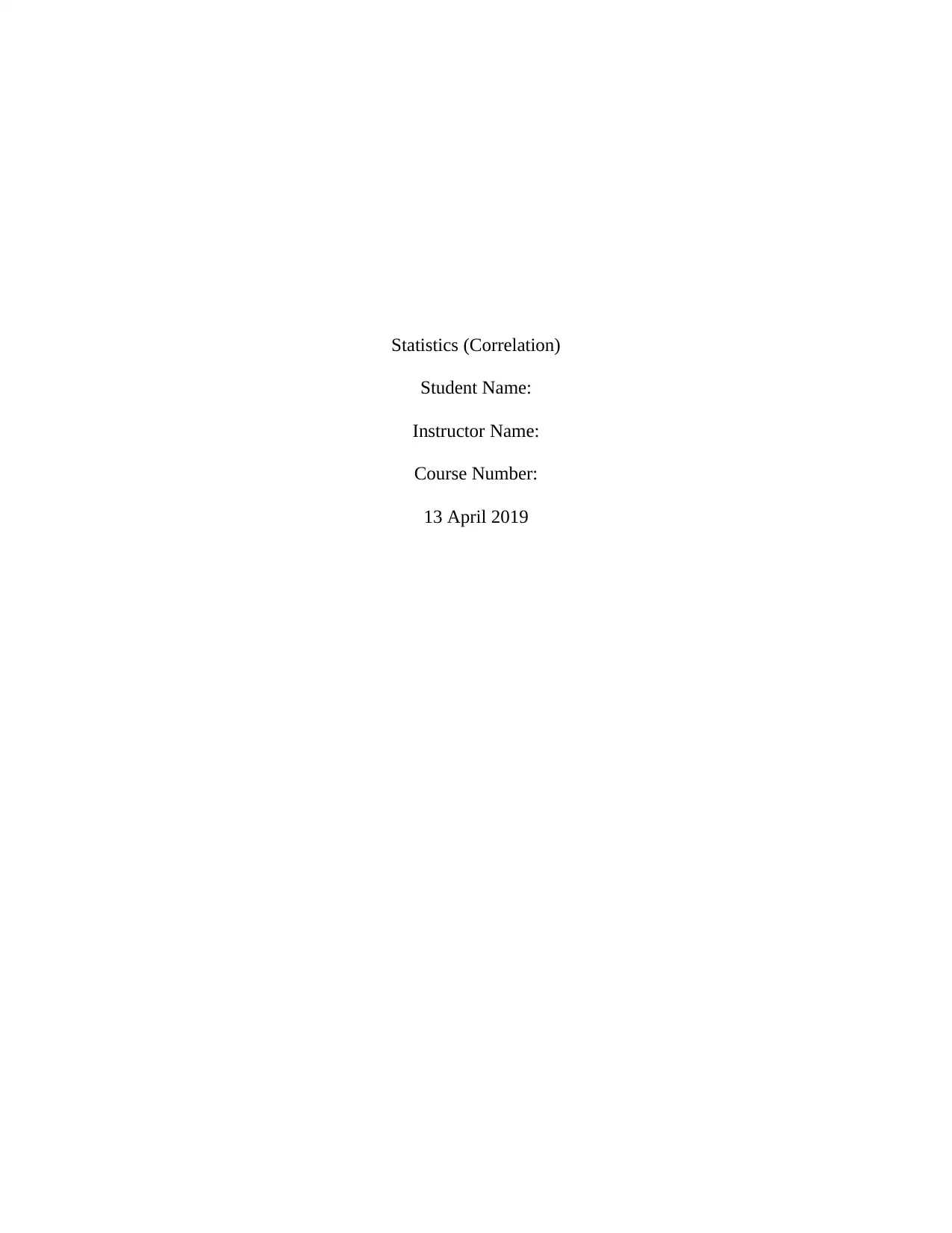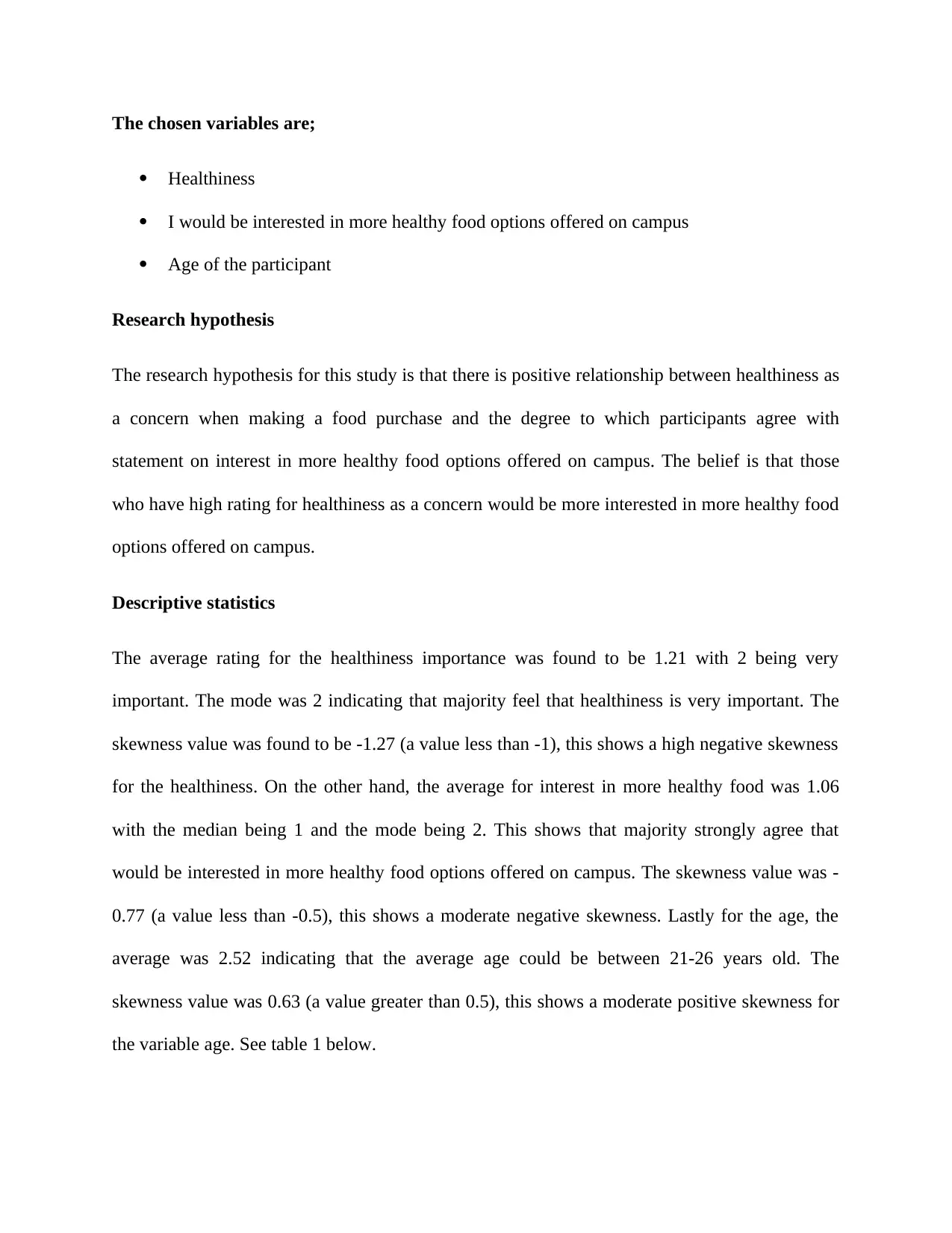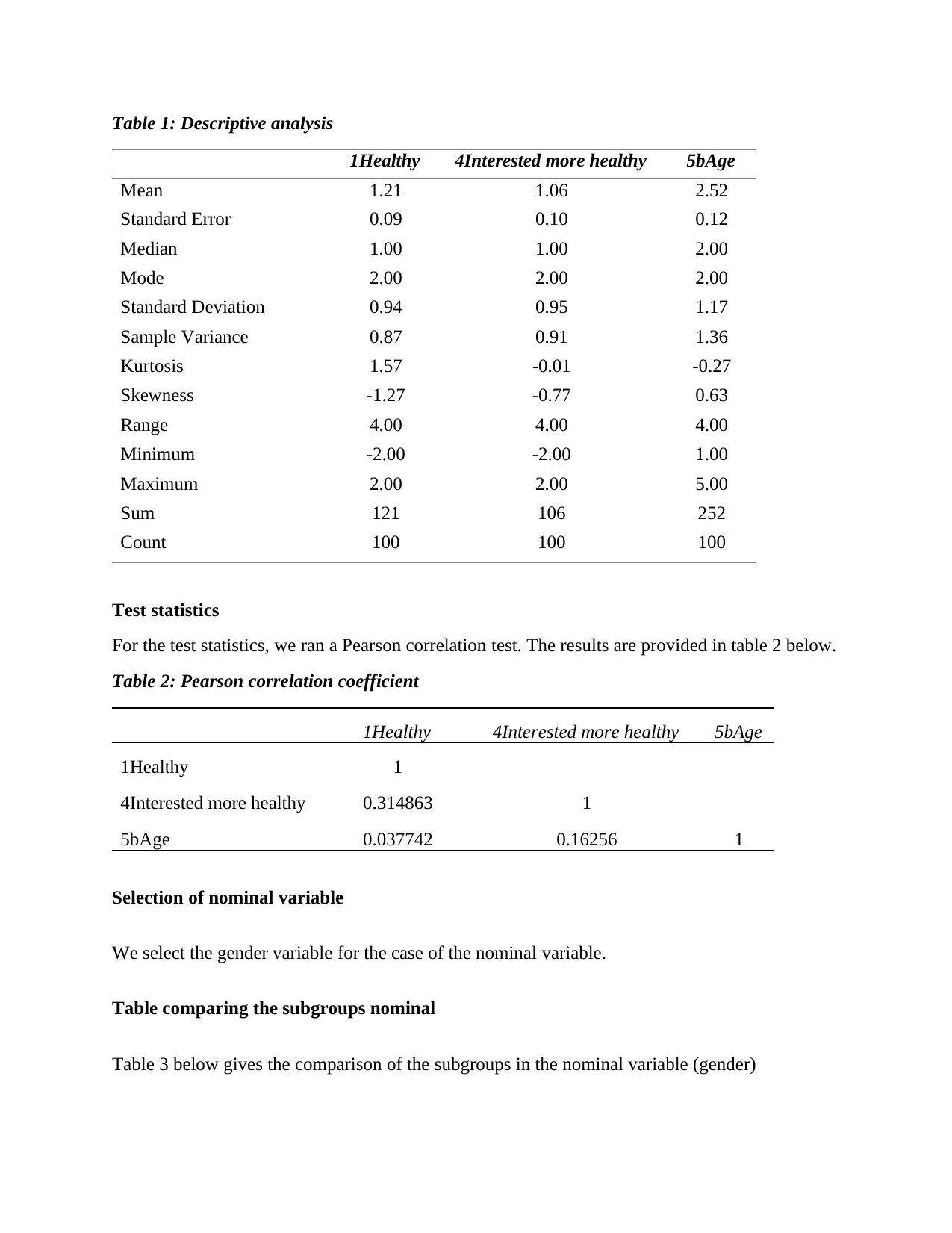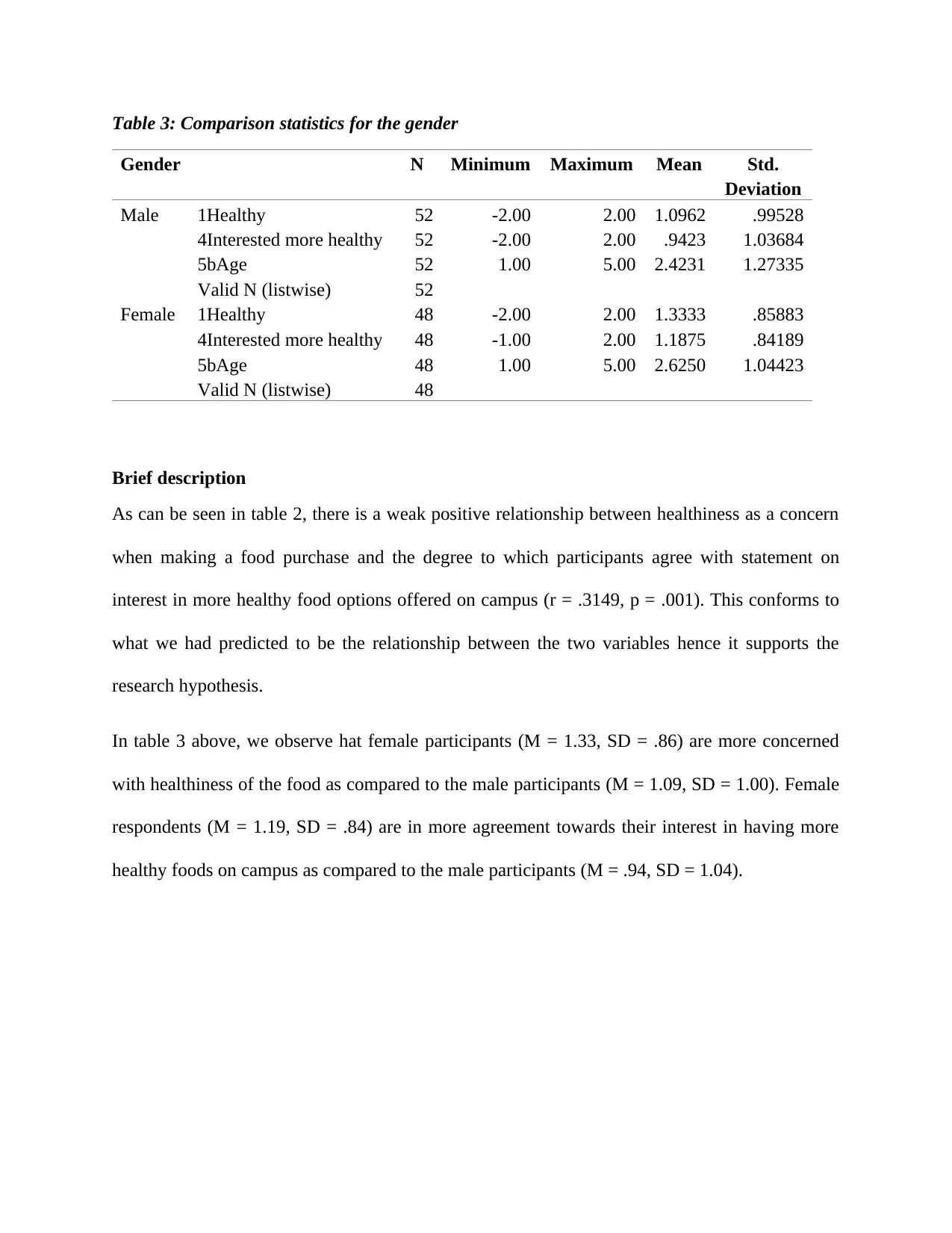Correlation Analysis of Food Preferences in STAT 1202
VerifiedAdded on 2023/01/18
|4
|666
|80
Homework Assignment
AI Summary
This document presents a solution to a statistics assignment focused on correlation analysis. The assignment investigates the relationship between healthiness as a concern when making food purchases and the level of interest in more healthy food options offered on campus. The analysis be...

Statistics (Correlation)
Student Name:
Instructor Name:
Course Number:
13 April 2019
Student Name:
Instructor Name:
Course Number:
13 April 2019
Paraphrase This Document
Need a fresh take? Get an instant paraphrase of this document with our AI Paraphraser

The chosen variables are;
Healthiness
I would be interested in more healthy food options offered on campus
Age of the participant
Research hypothesis
The research hypothesis for this study is that there is positive relationship between healthiness as
a concern when making a food purchase and the degree to which participants agree with
statement on interest in more healthy food options offered on campus. The belief is that those
who have high rating for healthiness as a concern would be more interested in more healthy food
options offered on campus.
Descriptive statistics
The average rating for the healthiness importance was found to be 1.21 with 2 being very
important. The mode was 2 indicating that majority feel that healthiness is very important. The
skewness value was found to be -1.27 (a value less than -1), this shows a high negative skewness
for the healthiness. On the other hand, the average for interest in more healthy food was 1.06
with the median being 1 and the mode being 2. This shows that majority strongly agree that
would be interested in more healthy food options offered on campus. The skewness value was -
0.77 (a value less than -0.5), this shows a moderate negative skewness. Lastly for the age, the
average was 2.52 indicating that the average age could be between 21-26 years old. The
skewness value was 0.63 (a value greater than 0.5), this shows a moderate positive skewness for
the variable age. See table 1 below.
Healthiness
I would be interested in more healthy food options offered on campus
Age of the participant
Research hypothesis
The research hypothesis for this study is that there is positive relationship between healthiness as
a concern when making a food purchase and the degree to which participants agree with
statement on interest in more healthy food options offered on campus. The belief is that those
who have high rating for healthiness as a concern would be more interested in more healthy food
options offered on campus.
Descriptive statistics
The average rating for the healthiness importance was found to be 1.21 with 2 being very
important. The mode was 2 indicating that majority feel that healthiness is very important. The
skewness value was found to be -1.27 (a value less than -1), this shows a high negative skewness
for the healthiness. On the other hand, the average for interest in more healthy food was 1.06
with the median being 1 and the mode being 2. This shows that majority strongly agree that
would be interested in more healthy food options offered on campus. The skewness value was -
0.77 (a value less than -0.5), this shows a moderate negative skewness. Lastly for the age, the
average was 2.52 indicating that the average age could be between 21-26 years old. The
skewness value was 0.63 (a value greater than 0.5), this shows a moderate positive skewness for
the variable age. See table 1 below.

Table 1: Descriptive analysis
1Healthy 4Interested more healthy 5bAge
Mean 1.21 1.06 2.52
Standard Error 0.09 0.10 0.12
Median 1.00 1.00 2.00
Mode 2.00 2.00 2.00
Standard Deviation 0.94 0.95 1.17
Sample Variance 0.87 0.91 1.36
Kurtosis 1.57 -0.01 -0.27
Skewness -1.27 -0.77 0.63
Range 4.00 4.00 4.00
Minimum -2.00 -2.00 1.00
Maximum 2.00 2.00 5.00
Sum 121 106 252
Count 100 100 100
Test statistics
For the test statistics, we ran a Pearson correlation test. The results are provided in table 2 below.
Table 2: Pearson correlation coefficient
1Healthy 4Interested more healthy 5bAge
1Healthy 1
4Interested more healthy 0.314863 1
5bAge 0.037742 0.16256 1
Selection of nominal variable
We select the gender variable for the case of the nominal variable.
Table comparing the subgroups nominal
Table 3 below gives the comparison of the subgroups in the nominal variable (gender)
1Healthy 4Interested more healthy 5bAge
Mean 1.21 1.06 2.52
Standard Error 0.09 0.10 0.12
Median 1.00 1.00 2.00
Mode 2.00 2.00 2.00
Standard Deviation 0.94 0.95 1.17
Sample Variance 0.87 0.91 1.36
Kurtosis 1.57 -0.01 -0.27
Skewness -1.27 -0.77 0.63
Range 4.00 4.00 4.00
Minimum -2.00 -2.00 1.00
Maximum 2.00 2.00 5.00
Sum 121 106 252
Count 100 100 100
Test statistics
For the test statistics, we ran a Pearson correlation test. The results are provided in table 2 below.
Table 2: Pearson correlation coefficient
1Healthy 4Interested more healthy 5bAge
1Healthy 1
4Interested more healthy 0.314863 1
5bAge 0.037742 0.16256 1
Selection of nominal variable
We select the gender variable for the case of the nominal variable.
Table comparing the subgroups nominal
Table 3 below gives the comparison of the subgroups in the nominal variable (gender)
⊘ This is a preview!⊘
Do you want full access?
Subscribe today to unlock all pages.

Trusted by 1+ million students worldwide

Table 3: Comparison statistics for the gender
Gender N Minimum Maximum Mean Std.
Deviation
Male 1Healthy 52 -2.00 2.00 1.0962 .99528
4Interested more healthy 52 -2.00 2.00 .9423 1.03684
5bAge 52 1.00 5.00 2.4231 1.27335
Valid N (listwise) 52
Female 1Healthy 48 -2.00 2.00 1.3333 .85883
4Interested more healthy 48 -1.00 2.00 1.1875 .84189
5bAge 48 1.00 5.00 2.6250 1.04423
Valid N (listwise) 48
Brief description
As can be seen in table 2, there is a weak positive relationship between healthiness as a concern
when making a food purchase and the degree to which participants agree with statement on
interest in more healthy food options offered on campus (r = .3149, p = .001). This conforms to
what we had predicted to be the relationship between the two variables hence it supports the
research hypothesis.
In table 3 above, we observe hat female participants (M = 1.33, SD = .86) are more concerned
with healthiness of the food as compared to the male participants (M = 1.09, SD = 1.00). Female
respondents (M = 1.19, SD = .84) are in more agreement towards their interest in having more
healthy foods on campus as compared to the male participants (M = .94, SD = 1.04).
Gender N Minimum Maximum Mean Std.
Deviation
Male 1Healthy 52 -2.00 2.00 1.0962 .99528
4Interested more healthy 52 -2.00 2.00 .9423 1.03684
5bAge 52 1.00 5.00 2.4231 1.27335
Valid N (listwise) 52
Female 1Healthy 48 -2.00 2.00 1.3333 .85883
4Interested more healthy 48 -1.00 2.00 1.1875 .84189
5bAge 48 1.00 5.00 2.6250 1.04423
Valid N (listwise) 48
Brief description
As can be seen in table 2, there is a weak positive relationship between healthiness as a concern
when making a food purchase and the degree to which participants agree with statement on
interest in more healthy food options offered on campus (r = .3149, p = .001). This conforms to
what we had predicted to be the relationship between the two variables hence it supports the
research hypothesis.
In table 3 above, we observe hat female participants (M = 1.33, SD = .86) are more concerned
with healthiness of the food as compared to the male participants (M = 1.09, SD = 1.00). Female
respondents (M = 1.19, SD = .84) are in more agreement towards their interest in having more
healthy foods on campus as compared to the male participants (M = .94, SD = 1.04).
1 out of 4
Your All-in-One AI-Powered Toolkit for Academic Success.
+13062052269
info@desklib.com
Available 24*7 on WhatsApp / Email
![[object Object]](/_next/static/media/star-bottom.7253800d.svg)
Unlock your academic potential
© 2024 | Zucol Services PVT LTD | All rights reserved.